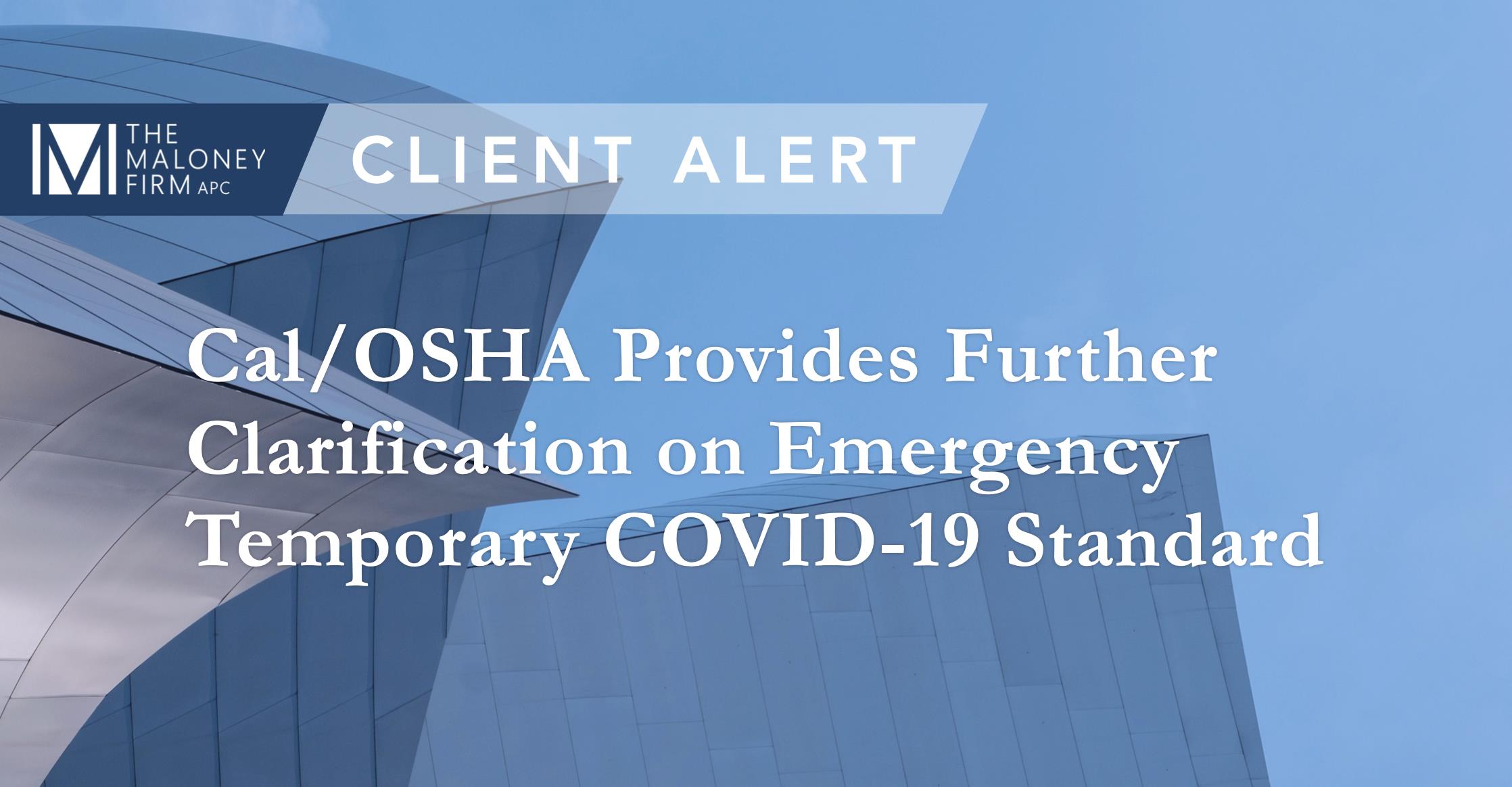Cal/OSHA Provides Further Clarification on Emergency Temporary COVID-19 Standard
Jan 21, 2021
On November 30, 2020, the California Department of Industrial Relation’s Office of Administrative Law (OAL) approved the Division of Occupational Safety and Health’s (Cal/OSHA) temporary emergency standards for COVID-19 infection prevention. These temporary standards apply to most California workers not covered by Cal/OSHA’s Aerosol Transmissible Diseases Standard (ATD).
.
Shortly after the Emergency Temporary Standards (ETS) went into effect in November, Cal/OSHA released their first set of Frequently Asked Questions (FAQs) and Templates to help clarify these new safety standards and testing and reporting requirements. However, the first set of FAQs left several critical questions unanswered and contradicted the standards published by the California Department of Health.
.
On December 14, 2020, Governor Newsom issued an Executive Order compelling Cal/OSHA to adhere to California Department of Public Health guidance. In response, Cal/OSHA released a second set of FAQs on January 8, 2021 to update and further clarify the ETS.
.
Employer Requirements under the Emergency Temporary COVID-19 Prevention Standards
.
Under the ETS, employers are required to:
- Establish, implement, and maintain an effective written COVID-19 Prevention Program that includes:
- Identifying and evaluating employee exposures to COVID-19 health hazards.
- Implementing effective policies and procedures to correct unsafe and unhealthy conditions (such as safe physical distancing, modifying the workplace, and staggering work schedules).
- Providing and ensuring workers wear face coverings to prevent exposure in the workplace.
- Provide effective training and instruction to employees on how COVID-19 is spread, infection prevention techniques, and information regarding COVID-19-related benefits that affected employees may be entitled to under applicable federal, state, or local laws.
Employers face further testing, reporting, and notification requirements when there are multiple COVID-19 infections and COVID-19 outbreaks in the workplace. Find Cal/OSHA’s fact sheet explaining employer requirements under the ETS here.
.
Noteworthy Updates in Cal/OSHA’s Second Set of FAQs
.
Updates on Earnings Continuation Requirement
.
Cal/OSHA’s COVID-19 Standards require employers to “maintain an employee’s earnings, seniority, and all other employee rights and benefits, including the employee’s right to their former job status, as if the employee had not been removed from their job” when employees are “able and available” to work and are removed from the workplace due to transmission-related concerns.
.
However, employees who are ill with COVID-19, as well as employees who are unable to return after they have completed the normal quarantine period due to illness, are ineligible for this continued earnings mandate. Instead, they may be eligible for Workers’ Compensation or State Disability Insurance benefits. Relatedly, employees who receive temporary disability workers’ compensation benefits are not entitled to the continued earnings provisions, as they are not considered “able and available to work.”
.
As we described previously, SB 1159 creates a statutory rebuttable presumption that certain employees who test positive for COVID-19 contracted the virus at work, which entitles them to workers’ compensation benefits. In order to rebut this presumption, employers must conduct “comparable investigations and produc[e] comparable evidence to show it is more likely than not that an employee’s COVID-19 exposure did not occur in the workplace.”[1] Employers that wish to rebut the presumption should follow this same framework.
.
Aerosol Transmissible Diseases (ATD) Standard
.
Cal/OSHA’s Emergency Temporary Standards (ETS) do not apply to:
- places of employment with one employee who does not have contact with others,
- employees working from home, and
- employees that are covered under Cal/OSHA’s Aerosol Transmissible Diseases (ATD) Standard.
For those covered by the ATD Standard and others in the healthcare industry, it is important to note that an employee in a single-person workplace cannot be subject to both the ETS and ATD standards.
.
Partitions in Fixed Workplaces
.
Employers are required under the ETS to install “cleanable solid partitions” at work locations where it is not possible to comply with the physical distancing requirements at all times. The new FAQs clarify that unless the workplace has “complete barriers” (likely meaning barriers that cover floor to ceiling), these partitions do not eliminate the risk of COVID-19 transmission and workers within six feet of one another should be considered close contacts for contact tracing, quarantine, and testing purposes.
.
Testing Location Considerations
.
When employers must provide their employees with testing for COVID-19, it need not be at their work location. Instead, as long as employees incur no cost for the testing, employers may refer employees to a free testing site, clinic, or their own physician. Ensuring that employees do not incur costs to get tested includes paying employees’ wages for their time to get tested and their travel time to and from the testing site and reimbursing employees for travel costs to the testing site (e.g., mileage or public transportation costs).
.
Relatedly, if an outbreak occurs in the workplace, employers are required to offer testing but are not required to mandate that employees get tested.
.
Quarantine and Return to Work Recommendations
.
Cal/OSHA’s quarantine length requirements were adjusted in accordance with updated guidance from the California Department of Public Health (CDPH). While Cal/OSHA still recommends that employees exposed to COVID-19 in the workplace quarantine for 14 days, exposed employees who do not develop symptoms may return to work 10 days after the date of their last known exposure. Cal/OSHA also updated their standards to permit healthcare, emergency response, and social services workers to return to work after 7 days with a negative PCR test result collected after day 5 when there is a critical staffing shortage.
.
While employers are allowed to request a waiver from the requirement to quarantine/isolate exposed or COVID-19 positive employees from the workplace if doing so would create an undue risk to public health and safety, Cal/OSHA has not yet provided clear guidance regarding the waiver submission process and criteria. However, Cal/OSHA specified that businesses that qualify for a waiver must provide goods or services that, if interrupted, “would cause an undue risk to a community’s health and safety.” This exception is more stringent than the definition of critical industries. Moreover, the business’s facility “must be facing a potential staffing shortage based on actual COVID-19 cases or exposures in order to qualify for a waiver.” Although Cal/OSHA does not define criteria that employers must meet to be granted a waiver, the agency outlines specific information that employers could provide to constitute a complete waiver request.
.
Determining Outbreaks
.
When there are COVID-19 outbreaks in the workplace, employers are subject to testing and reporting requirements under the ETS. A workplace outbreak occurs when there are three or more cases in a workplace in a 14-day period, and a major outbreak occurs when there are 20 or more cases in a 30-day period.
.
In order to measure the 14- or 30- day period to determine if an outbreak or major outbreak has occurred under Cal/OSHA’s standards, employers should look to the testing date of the cases; employers should review “any cases for which the tests occurred within a 14-day period…to see if the other criteria for an outbreak have been met.”
.
For the purposes of determining outbreaks, employers who have several non-overlapping work shifts at a facility may consider each shift a separate “exposed workplace” if “the facility is well ventilated and the cleaning and disinfection requirements of the ETS are met between or before shift changes.”
.
Resources for California Employers
.
Find the full text of Cal/OSHA’s Emergency Temporary Standards here.
.
Find the full text of Cal/OSHA’s COVID-19 Emergency Temporary Standards Frequently Asked Questions here.
.
Find the Cal/OSHA Aerosol Transmissible Diseases (ATD) Standards here.
.
If you have questions regarding the application of Cal/OSHA’s Emergency Temporary COVID-19 Standards to your business, please contact one of the following attorneys in The Maloney Firm’s Employment Law Department: Patrick Maloney, Lisa Von Eschen, Samantha Botros, or Nicholas Grether.
[1] https://www.dir.ca.gov/dosh/coronavirus/COVID19FAQs.html#footnote



